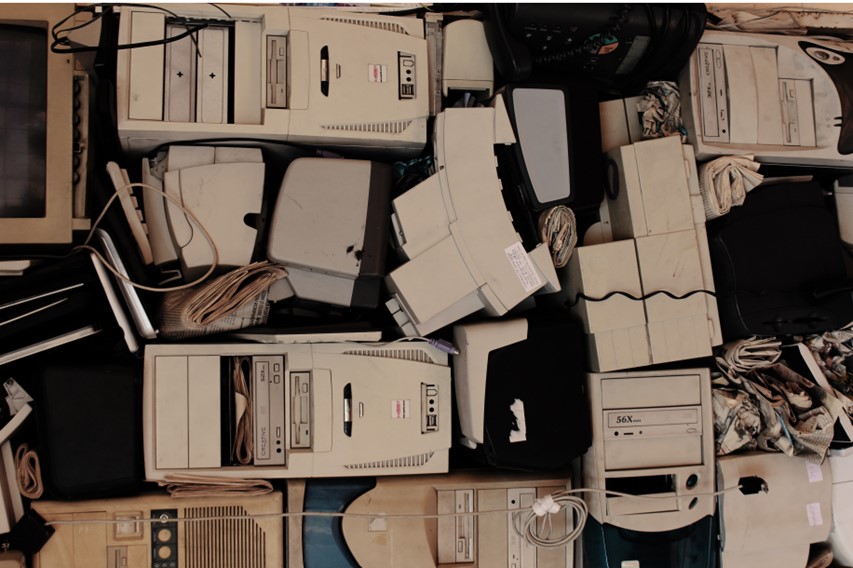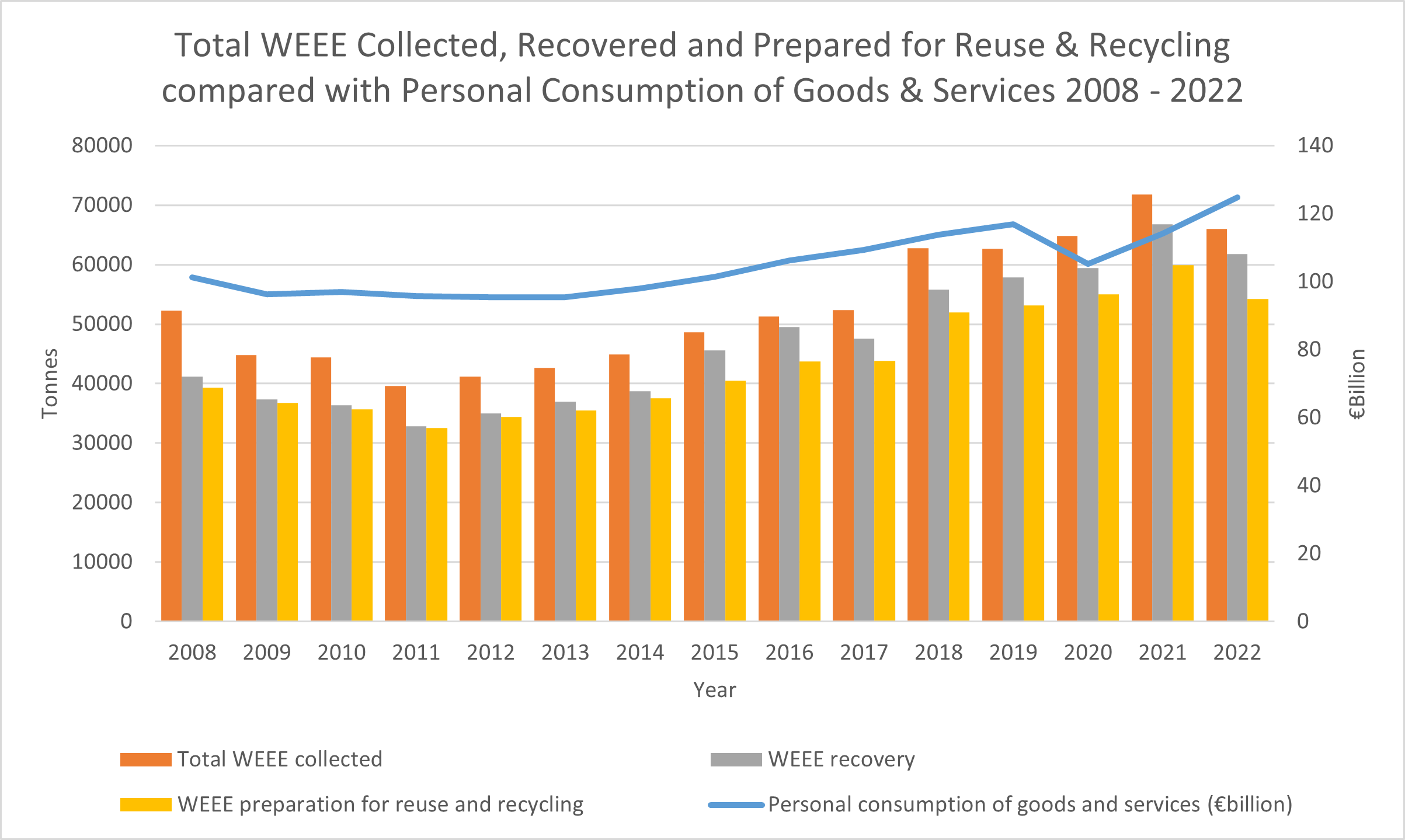EPA waste data release, February 2024. Latest reference year 2022 (data subject to Eurostat validation).
This data release presents the Waste Electrical and Electronic Equipment (WEEE) statistics for Ireland for the reference year 2022.
WEEE has become one of the fastest growing waste streams worldwide due to an unprecedented level of electronics being produced. It is also one of the most hazardous if not managed properly causing major health and environmental problems.

Table 1 Ireland’s WEEE recycling and recovery rates in 2022, compared with EU targets.
| Categories | WEEE Collected Tonnes | EU recovery target | Ireland’s recovery percentage | EU preparation for reuse and recycling target | Ireland’s preperation for reuse and recycling percentage | |
| 1 | Temperature exchange equipment | 9,851 | 85% | 97% | 80% | 82% |
| 2 | Screens, monitors, and equipment containing screens having a surface greater than 100cm2 | 3,507 | 80% | 98% | 70% | 78% |
| 3 | Lamps | 309 | Not applicable | 97% | 80% | 83% |
| 4 | Large equipment (any external dimension more than 50cm | 35,131 | 85% | 93% | 80% | 86% |
| 5 | Small equipment (no external dimension more than 50 cm) | 13,118 | 75% | 91% | 55% | 72% |
| 6 | Small IT and telecommunication equipment (no external dimension more than 50 cm) | 4,101 | 75% | 99% | 55% | 85% |
| Total WEEE Collected, Sent for (i) Recovery, (ii) Prepared for Reuse & Recycling in 2022 (Tonnes) | 66,018 | (i) 61,808 | (ii) 54,245 | |||
| Total WEEE Collected, Sent for (i) Recovery, (ii) Prepared for Reuse & Recycling in 2021 (Tonnes) | 71,811 | (i) 66,811 | (ii) 59,896 |
Open in Excel: Table 1: WEEE recovery rates 2022 (XLS 10KB)
Open in CSV : Table 1: WEEE recovery rates 2022 (CSV 1KB)[1] What we Consumed - CSO - Central Statistics Office

Figure 2 WEEE Collected and recovered 2008-2022 compared with personal consumption of goods and services
The recycling of WEEE protects both human health and the environment. WEEE contains hazardous materials which can cause serious damage if not discarded of correctly. Many devices also contain rare and valuable components that can be recycled and reused in new products reducing the extraction of raw materials which has harmful environmental and social effects. Improving the collection, treatment, and recycling of WEEE enhances resource efficiency and supports the transition to a circular economy.
Despite the general improvements in the collection of WEEE in Ireland, there is evidence from the EPA’s 2022 Waste Characterisation Report that substantial amounts are still present in household bins. These accounted for 0.8% of waste in the residual bin (6,179t) and 0.4% of waste in the recycling bin (1,115t). These items should never go in household bins as they are hazardous.
It’s free to bring electrical items and waste batteries to recycling centres and participating retailers. Raising awareness and ensuring that WEEE is separately collected through available channels will help to further improve Ireland’s collection rate. This allows for the maximum extraction of valuable and scarce materials and ensure that hazardous materials are treated correctly.
Ireland has yet to achieve the new EU WEEE collection target of 65% which will require continued stakeholder engagement and targeted efforts to improve the collection of both household and professional (B2B) WEEE. An EPA-led multi-stakeholder WEEE Collection Working Group is driving this effort. The collection rate for 2022 will be released when Placed on the Market (POM) data is available in 2024.
Transitioning to a circular economy requires breaking the link between economic activity and resource consumption. Improvements in design to extend product lifetimes and to allow for repair, refurbishment and reuse are needed to ensure that electrical products remain in circulation for longer and can be fully recycled at the end of their life.
The EU WEEE Directive (2012/19/EC) aims to ensure that WEEE is collected and managed in an environmentally friendly way. It sets an overall WEEE collection target of 65% (which is based on quantity of WEEE collected relative to the average weight of EEE placed on the market in the three preceding years) and also sets individual targets for the recycling, reuse and recovery of six different categories of WEEE (detailed in Table 1):
The WEEE Directive is a Producer Responsibility Initiative (PRI) Directive, where the producers of EEE have responsibility for the environmentally sound management of products at their end of life. Most collection and treatment of WEEE in Ireland is organised and financed by the two approved producer compliance schemes, WEEE Ireland (www.weeeireland.ie) and European Recycling Platform Ireland (www.erp-recycling.ie). These schemes cover private household WEEE (B2C WEEE). Industry is directly responsible for management of non-private household WEEE in Ireland (B2B WEEE).
The EPA uses data from a number of sources to compile the WEEE collection and treatment statistics for Ireland. The three main data sources are: (1) data from authorised Irish waste treatment facilities, reported by facilities to the EPA and the National Waste Collection Permit Office; (2) datasets compiled by the ‘WEEE from private households’ (B2C) producer compliance schemes; and (3) Waste Management Reports submitted by ‘WEEE from other than private households’ (B2B) producers to the EPA. Data gaps are identified and filled by cross-checking the data with waste collection records held by the National Waste Collection Permit Office and with waste export/import data held by National TransFrontier Shipment Office. The WEEE collection target is calculated using data on EEE placed on the Irish market supplied by the Producer Register Limited, Ireland’s national register of EEE.
As part of annual reporting under the EU WEEE Directive, the EPA compiles statistics on WEEE collection and treatment in Ireland. The data are required to be submitted to Eurostat, the statistical office of the European Union, by 30th June of the reference year +2 (i.e. 2022 data was collected and processed in 2023 and will be reported in 2024). Following validation of the data by Eurostat, official statistics for all Member States are published on the Eurostat website as part of the following dataset: